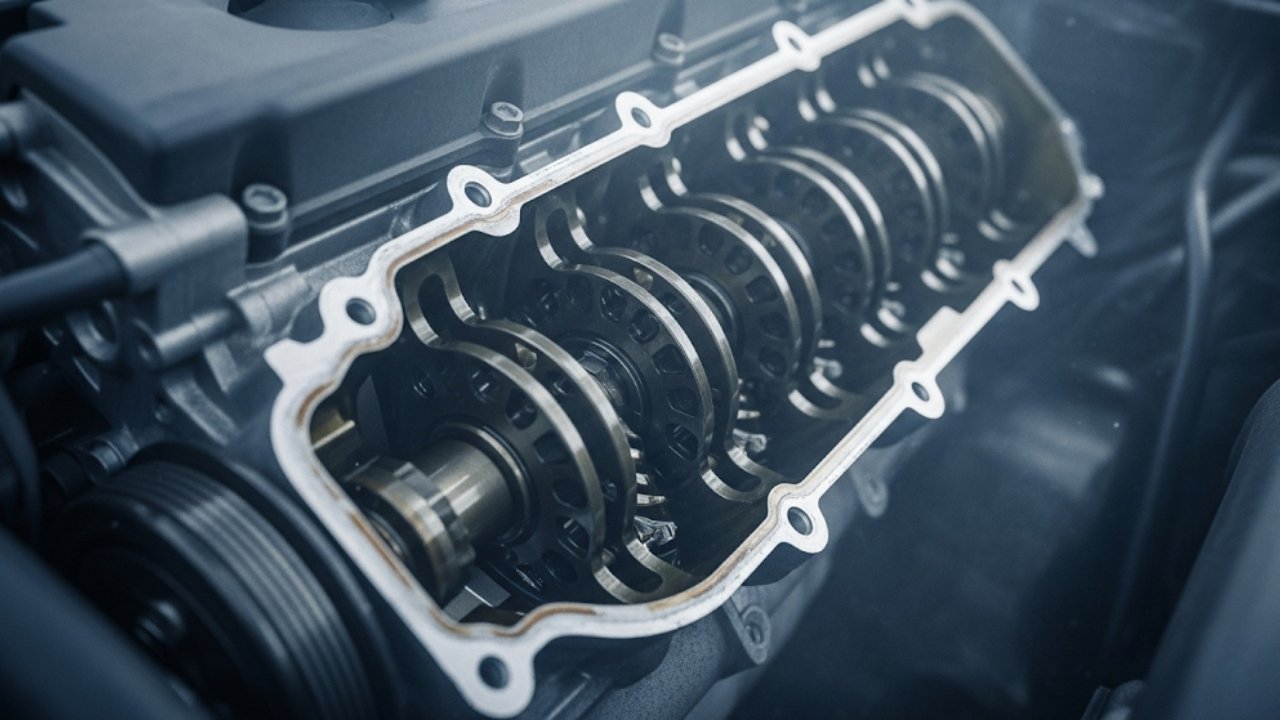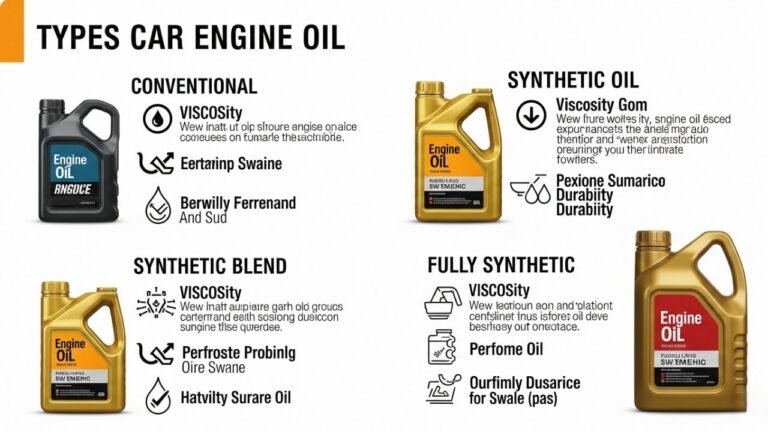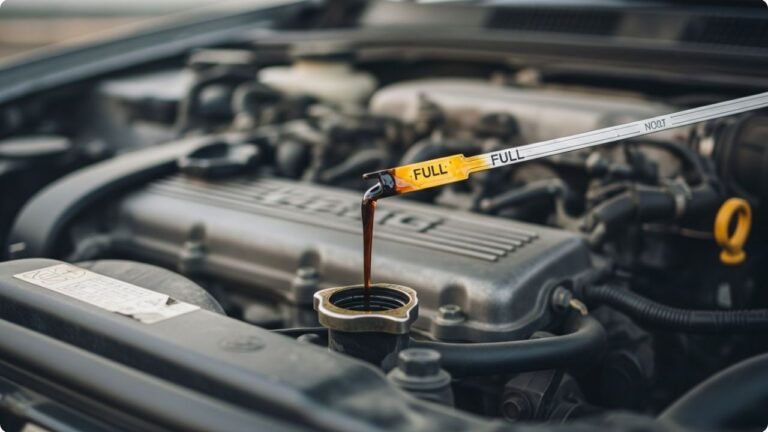Why Is There No Oil in My Car?

One morning, you pop the hood, pull out the dipstick, wipe it clean, dip again, and… nothing. No oil. Your heart sinks.
How did this happen?
You’re not alone. Many drivers—especially those new to car maintenance—have asked themselves, “why is there no oil in my car?” It’s a scary moment. A car without oil is like a human without blood. And while it might not scream for help immediately, damage could already be brewing beneath the surface.
I’ve been there too. In college, driving my beat-up Toyota Corolla, I once drove nearly 1,000 miles without checking the oil. Spoiler alert: I ended up with a nearly seized engine. Lesson learned the hard way.
In this article, we’ll uncover why your car might suddenly have no oil, what to check, how to prevent it, and how to react fast—before the damage gets worse. We’ll mix facts with real stories, cultural references, and a tone that feels like chatting with a trusted friend. Let’s dive deep.
In This Article
- 1 The Oil Didn’t Magically Vanish—But It Might’ve Disappeared Quietly
- 2 Oil Leaks: The Silent Drain You Might Miss
- 3 Burning Oil: When It’s Getting Used Up—Just Not the Way You Want
- 4 Poor Maintenance Habits Can Dry Your Engine
- 5 Faulty Gaskets and Seals: The Tiny Parts That Can Create Big Problems
- 6 Oil Filter or Drain Plug Issues After a Recent Oil Change
- 7 Internal Engine Damage: The Worst-Case Scenario
- 8 How to Check Your Oil Like a Pro (Even if You’re a Beginner)
- 9 What to Do When There’s No Oil in Your Car (Step-by-Step Fix)
- 10 Habits That Help You Prevent Oil Disappearance
- 11 Cultural Insight: Why Many Drivers Ignore Oil Until It’s Too Late
- 12 FAQs: Quick Answers for Common Concerns
- 12.1 Can a car run with no oil at all?
- 12.2 How do I know if my car has no oil without a dipstick?
- 12.3 Why is there no oil in my car after an oil change?
- 12.4 Can I just top off oil instead of changing it?
- 12.5 What oil should I use if I’m not sure?
- 12.6 Is driving with low oil better than no oil?
- 12.7 How much oil does a car typically need?
- 12.8 Can hot weather cause oil to disappear faster?
- 13 Final Thoughts: Listen to the Dipstick—It Doesn’t Lie
The Oil Didn’t Magically Vanish—But It Might’ve Disappeared Quietly
Let’s start with a truth bomb: engine oil doesn’t just vanish without reason. There’s always a cause. But the tricky part? It can disappear slowly and silently.
Here’s what could be happening behind the scenes:
-
Oil leaks: Your oil could be dripping under the engine, unnoticed.
-
Burning oil: Older engines or high-mileage cars might burn oil internally.
-
Neglecting oil changes: Old oil breaks down and can evaporate or sludge up.
-
Faulty seals or gaskets: These allow oil to seep out slowly over time.
-
Oil consumption by engine design: Some car brands, like Audi or Subaru, are infamous for using more oil than you’d expect.
If you’re wondering “why is there no oil in my car”, it’s likely one of these sneaky culprits. Let’s break each down clearly.
Oil Leaks: The Silent Drain You Might Miss

In cars, leaks usually occur due to:
-
Worn valve cover gaskets
-
Cracked oil pans
-
Loose oil drain plugs
-
Failing oil filter seals
You might not even notice unless you see dark spots under your car or smell burning oil when the engine is hot.
Common Oil Leak Points vs Symptoms
| Leak Location | Symptom |
|---|---|
| Valve cover gasket | Oil on engine or burning smell |
| Oil pan or drain plug | Oil puddle under car |
| Front/rear main seal | Dripping from engine-transmission line |
| Oil filter housing | Wet area near filter |
Tip: Park on clean pavement overnight. Check for dark stains in the morning. If you spot some, you’ve got an oil leak.
Burning Oil: When It’s Getting Used Up—Just Not the Way You Want
Some engines “eat” oil as they age. Not literally, but through internal oil consumption, where oil sneaks past worn piston rings or valve guides and burns off in the combustion chamber.
You might notice:
-
Blue smoke from the tailpipe
-
Frequent top-ups needed
-
Excessive oil loss without external leaks
In these cases, you won’t see a leak—but you’ll still lose oil.
Back when I owned a 2005 Camry with over 200,000 miles, I’d check the dipstick every week. That engine burned half a quart every 800 miles. It taught me a valuable rule of thumb: high-mileage cars need more love (and more oil).
Poor Maintenance Habits Can Dry Your Engine
Let’s get real. Sometimes the problem isn’t mechanical—it’s us. Forgetting to check or change your oil can lead to the dreaded “dry dipstick.”
Here’s how:
-
Skipping oil changes: Over time, oil breaks down, becomes sludge, or evaporates.
-
Running too long between top-offs: Even if there’s no leak or burning, engines slowly use oil.
If you don’t check the dipstick regularly—say, once a month or every 1,000 miles—you won’t notice the slow disappearance until it’s too late.
Bullet Points: Bad Habits That Lead to No Oil
-
Ignoring the oil warning light
-
Going 10,000+ miles without a change
-
Topping up without checking actual levels
-
Using the wrong type of oil
Friendly reminder: Your car won’t nag like your mom—but it still needs regular check-ins.
Faulty Gaskets and Seals: The Tiny Parts That Can Create Big Problems
Tiny rubber parts like the valve cover gasket, rear main seal, or oil pan gasket might not look impressive—but they’re crucial in keeping oil where it belongs.
When these seals fail, oil leaks out slowly, especially when the engine is off or cooling down.
Here’s what to look for:
-
Musty or burnt smell after driving
-
Visible grime on engine parts
-
Gradual dip in oil levels without obvious drips
It’s kind of like a slow leak in a bicycle tire—you won’t feel it until the pressure’s gone. Except here, your engine could overheat or seize.
If you’re wondering again “why is there no oil in my car”, it’s worth getting a mechanic to do a pressure test to check for these internal culprits.
Oil Filter or Drain Plug Issues After a Recent Oil Change
Did you recently get an oil change?
If your car has no oil after a service, it could be due to:
-
A loose drain plug
-
A poorly seated oil filter
-
The wrong oil amount added
These mistakes, while rare, happen more than you’d think—especially at quick-lube chains. I once had an oil filter gasket installed improperly, and it dumped my oil on the freeway within minutes. A kind trucker flagged me down. That act probably saved my engine.
Always double-check oil level a day after service. It takes two minutes—and can save you thousands.
Internal Engine Damage: The Worst-Case Scenario
If your engine has serious internal damage, like:
-
A cracked engine block
-
A blown head gasket
-
A hole in the oil pan
…you might see no oil, even right after adding some.
This is rare but possible—especially after overheating, running dry, or ignoring warning lights. You might even see a milky substance on your dipstick, meaning oil mixed with coolant—a sign of a blown gasket.
This is when you call a trusted mechanic. Or, let’s be honest—sometimes it’s time to say goodbye to the car.
How to Check Your Oil Like a Pro (Even if You’re a Beginner)
You don’t need to be a mechanic to master this. Checking your oil is quick, easy, and essential. Think of it as brushing your teeth—but for your engine’s health.
Here’s how to do it:
-
Park on a flat surface and let the engine cool for at least 10 minutes.
-
Pop the hood and locate the dipstick—usually a bright handle (yellow/orange).
-
Pull it out, wipe clean, and dip it back in fully.
-
Pull out again and read the level:
-
If it’s between the two marks, you’re good.
-
If it’s below the bottom mark, you’re low or empty.
-
If it’s bone dry, that’s when you panic—but also take action.
-
Also, check oil color and texture. Thick, black, or sludgy oil? Time to change it. Milky or frothy? Call a mechanic—coolant might be mixing in.
Pro tip: Keep a small funnel and a quart of your recommended oil in the trunk. It’s like carrying a phone charger—essential for emergencies.
What to Do When There’s No Oil in Your Car (Step-by-Step Fix)
So, you’ve confirmed it—no oil in the engine. Here’s what you should do immediately to avoid damage.
Step-by-Step:
-
Do NOT start the engine: Running dry even for 30 seconds can ruin components.
-
Check for visible leaks: Look under the car for puddles or stains.
-
Inspect the oil filter and drain plug: If you’re recently serviced, this could be loose.
-
Top up with the correct oil: Use your owner’s manual to find the right viscosity.
-
Add oil slowly—about half a quart at a time, rechecking the dipstick.
-
Once full, start the engine and listen for knocking or ticking.
-
Watch for the oil warning light. If it stays on, turn off the engine and seek help.
If You’re Still Not Sure:
-
Drive carefully to a trusted shop or have it towed.
-
Request a leak test or inspection.
-
If repairs are needed, get quotes and ask for parts breakdowns.
Important reminder: Don’t rely solely on the oil light. By the time it comes on, the damage may have started. Trust your dipstick.
Habits That Help You Prevent Oil Disappearance
Now that we’ve talked about problems, let’s talk prevention. These small habits keep oil levels in check and engines running smooth.
Healthy Oil Habits:
-
Check oil monthly—especially before long trips.
-
Change oil every 3,000 to 5,000 miles (or as per your car’s manual).
-
Use quality oil that meets your engine’s specs.
-
Listen to your car: Ticking, overheating, or poor acceleration could be oil-related.
-
Fix leaks fast—don’t delay “small drips.”
Maintenance Schedule for Oil Health
| Task | Frequency |
|---|---|
| Check oil level | Monthly |
| Change oil & filter | Every 3k–5k miles |
| Inspect for leaks | Every oil change |
| Monitor burning smell | Ongoing |
| Clean engine area (visuals) | Every 6 months |
Think of these tasks like brushing, flossing, and dental check-ups—for your engine.
Cultural Insight: Why Many Drivers Ignore Oil Until It’s Too Late
In many countries—especially in hot, humid climates like Bangladesh, India, or the southern U.S.—we focus more on fuel than fluids. Petrol gets attention. Oil gets forgotten.
In some places, public transport culture means many new car owners don’t grow up around DIY maintenance. Mechanics are trusted completely. But even then—trust needs verification.
There’s also a stigma: “I’m not a mechanic, I shouldn’t mess with the engine.”
But let me say this: you don’t have to be a mechanic to protect your car. Just a curious owner.
Think of oil like food for your engine. No one has to be a chef to know when the fridge is empty.
FAQs: Quick Answers for Common Concerns
Can a car run with no oil at all?
Technically, yes—for a few seconds or minutes. But it’s dangerous. No oil = no lubrication, which leads to metal-on-metal grinding, heat, and engine seizure.
How do I know if my car has no oil without a dipstick?
Some newer cars have electronic oil level sensors. Check your infotainment display or consult the manual. If it reads “low oil,” take it seriously.
Why is there no oil in my car after an oil change?
It could be due to:
-
Poor installation (filter or plug)
-
Wrong oil amount added
-
Major internal leak
Always double-check levels after service.
Can I just top off oil instead of changing it?
Topping off occasionally is fine. But old oil breaks down. It won’t protect like fresh oil. Change it regularly—even if the level seems okay.
What oil should I use if I’m not sure?
Check the owner’s manual. If you’ve lost it, try:
-
5W-30 for most modern cars
-
10W-40 for older engines
But still—confirm with a trusted source.
Is driving with low oil better than no oil?
Technically yes—but it’s still risky. Low oil can still damage parts like camshafts or valves. Always refill ASAP.
How much oil does a car typically need?
Most cars need 4 to 5 quarts. Trucks and SUVs may need more. Use your manual to verify.
Can hot weather cause oil to disappear faster?
Yes—especially in older engines or thin oil grades. Heat can increase evaporation and consumption, especially if you’re stuck in traffic a lot.
Final Thoughts: Listen to the Dipstick—It Doesn’t Lie
Let’s be real: car oil is easy to ignore, until it’s gone.
Just like relationships, your car engine needs regular attention, quality input, and care. Ignoring oil levels is like ignoring red flags—eventually, something breaks.
So the next time you ask, “why is there no oil in my car?”, you’ll know what to check, what it means, and how to fix it.
And if you remember just one thing from this article: check your dipstick once a month. It might just save your engine—and your wallet.






